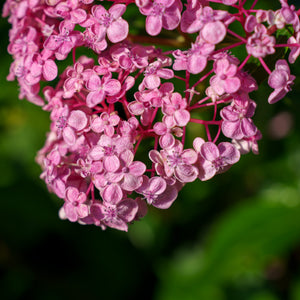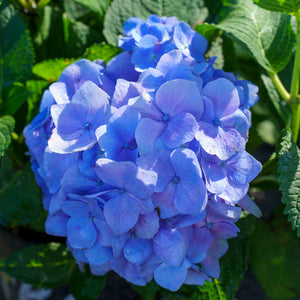The Hydrangea Guide
Hydrangeas are among the most beloved flowering shrubs in North American landscapes, prized for their lush foliage, stunning flower clusters, and long-lasting blooms. With dozens of cultivars spanning climbing, mophead, panicle, oakleaf, and mountain types, hydrangeas offer nearly unlimited options for gardens of all sizes and styles. Their ability to change color, bloom from spring to fall, and thrive in containers or borders makes them one of the most versatile plants available.
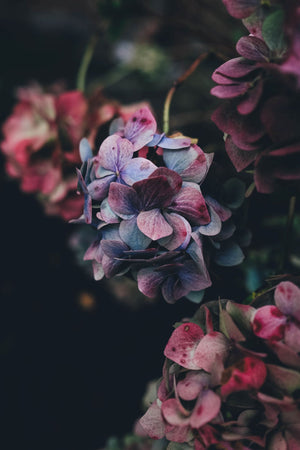
About
The Hydrangea genus includes a variety of species, each with unique traits that influence flower shape, size, pruning requirements, and sun tolerance.
Hydrangea macrophylla (Bigleaf Hydrangea)
Known for large, globe-shaped flowers (mophead) or flattened lacecap blooms, these hydrangeas often change flower color based on soil pH. Common cultivars include:
- 'Endless Summer BloomStruck', ‘Bailmer’, and ‘Summer Crush’ – reblooming varieties for extended color
- 'Zebra' – striking white blooms with dark stems
- ‘Let's Dance Rhythmic Blue’ – compact rebloomer with deep blue tones
Hydrangea paniculata (Panicle Hydrangea)
Sun-loving and cold-hardy, panicle hydrangeas feature cone-shaped blooms that often shift in color over the season. Highlights include:
- ‘Limelight’, ‘Phantom’, and ‘Vanilla Strawberry’ – large varieties with bold presence
- ‘Pinky Winky’, ‘Quick Fire’, and ‘Berry White’ – colorful bloomers with strong stems
- 'Jane' and ‘SMHPFL’ – dwarf selections ideal for smaller spaces
Hydrangea arborescens (Smooth Hydrangea)
Native to the eastern U.S., these are among the easiest to grow and bloom on new wood. Popular cultivars include:
- ‘Annabelle’ – classic white flower heads
- ‘Incrediball’ – stronger stems and larger blooms
- ‘Invincibelle Wee White’ – compact form with consistent flowering
Hydrangea quercifolia (Oakleaf Hydrangea)
Named for their deeply lobed leaves and stunning fall color, oakleaf hydrangeas tolerate more sun and drier conditions than others. Cultivars include:
- ‘Alice’, ‘Snow Queen’, ‘Ruby Slippers’, and ‘Gatsby Moon’ – noted for strong fall foliage and bloom structure
Hydrangea serrata (Mountain Hydrangea)
More compact and cold-tolerant than macrophylla, these hydrangeas are ideal for partial shade and containers. Look for:
Hydrangea anomala petiolaris (Climbing Hydrangea)
This vine-like species climbs by aerial roots and produces lacy white flowers in early summer. Excellent for walls, fences, or tree trunks in partial shade.
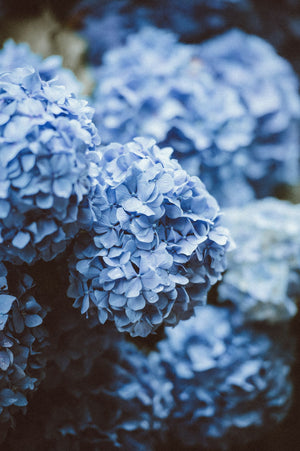
PLANTING
Each hydrangea species has slightly different requirements, but all benefit from careful placement and soil preparation.
USDA Hardiness Zones:
- macrophylla, serrata: Zones 5–9
- arborescens, quercifolia: Zones 4–9
- paniculata: Zones 3–8
- anomala petiolaris: Zones 4–8
Soil: Moist, well-drained, and rich in organic matter. Bigleaf and mountain hydrangeas prefer slightly acidic soils for blue flower tones.
Sunlight:
- macrophylla, serrata, quercifolia: Morning sun with afternoon shade
- paniculata and arborescens: Full sun to part shade
- climbing hydrangea: Partial to full shade
Watering: Hydrangeas need consistent moisture, especially in summer. Oakleaf and panicle hydrangeas are more drought-tolerant once established.
Spacing:
- Large cultivars (e.g., ‘Limelight’, ‘Alice’): 6–8 feet apart
- Compacts (e.g., ‘Summer Crush’): 2–4 feet apart
- Climbing types: 5–6 feet apart with vertical support
Planting Time: Spring or early fall is ideal. Avoid planting during summer heat or winter dormancy in cold regions.
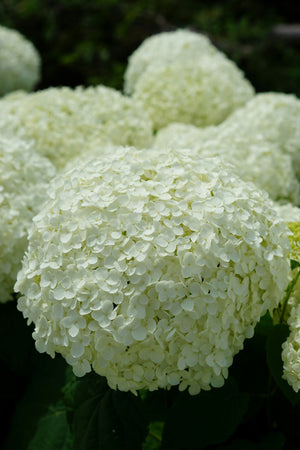
CARE
Hydrangeas are easy to grow but benefit from species-specific care for optimal performance.
Watering: Water deeply 1–2 times per week. Increase frequency during hot spells or in sandy soils.
Fertilizing: Feed in early spring with a slow-release fertilizer. For bigleaf types, use formulas suited for acid-loving plants if trying to maintain blue blooms.
Pruning:
- macrophylla and serrata: Prune after flowering unless they are rebloomers
- arborescens and paniculata: Prune in late winter or early spring—they bloom on new wood
- quercifolia: Light shaping in early spring
- climbing hydrangea: Minimal pruning—remove spent blooms or stray shoots after flowering
Pests & Diseases: Generally pest-free. Watch for powdery mildew, aphids, and leaf spot in overly damp or crowded plantings.
Mulching: Apply 2–3 inches of mulch to retain soil moisture and regulate temperature. Keep mulch away from the base of stems.
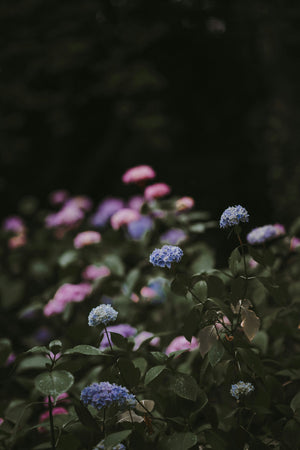
HOW TO USE
Hydrangeas are one of the most versatile flowering shrubs available, thriving in everything from woodland gardens to formal borders and foundation plantings. Their long bloom time and variety of forms make them exceptional design elements in nearly every setting.
Focal Point: Use large, upright selections like ‘Limelight’, ‘Gatsby Moon’, or ‘Annabelle’ as focal point shrubs in garden beds, entryways, or open lawn areas. Their showy blooms and seasonal transitions draw attention from spring through fall.
Mixed Borders: Combine hydrangeas with hostas, astilbes, ferns, and shade-loving grasses for a rich, layered border. In sunnier spots, pair panicle or smooth hydrangeas with echinacea, salvia, or sedum for a multi-season display.
Foundation Plantings: Compact varieties like ‘Summer Crush’, ‘Zebra’, or ‘Invincibelle Wee White’ are ideal for front-of-house placements. Use their long flowering time to anchor perennial beds or soften hardscapes.
Hedges and Screens: Panicle types like ‘Phantom’ or ‘Berry White’ form dense screens over time. Plant in rows and prune annually to encourage full growth and consistent shape.
Containers and Small Spaces: Choose dwarf hydrangeas like ‘Jane’, or ‘Mini Penny’ for pots or courtyards. Ensure pots have excellent drainage and protect containers over winter in colder zones.
Pollinator and Wildlife Gardens: Hydrangea flowers provide nectar to pollinators and their dense structure creates habitat for birds and beneficial insects. Combine with native plants for ecological value.
Woodland Gardens: Oakleaf, climbing, and mountain hydrangeas shine in shaded, naturalistic plantings. Their foliage and flowers blend beautifully with understory trees and groundcovers.
Cut Flower and Drying Gardens: Hydrangea blooms are prized in floral arrangements. Panicle and bigleaf types are particularly useful for both fresh-cut and dried flower crafts.
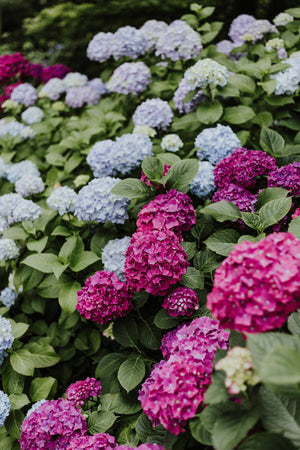
Common Questions
How to prune hydrangea? Prune based on species. Bigleaf and mountain hydrangeas bloom on old wood—prune after flowering. Panicle and smooth hydrangeas bloom on new wood—prune in late winter or early spring. Minimal pruning is needed for climbing and oakleaf types.
Do deer eat hydrangea? Hydrangeas are moderately deer-resistant. Deer may nibble on young shoots and flower buds, especially in spring. Protection is advised in high-pressure areas.
How to propagate hydrangea? Take softwood cuttings in late spring or early summer and root them in moist soil or water. Some types can also be layered by bending a low branch to the ground and allowing it to root.
How large do hydrangea get? Size varies widely. Dwarfs stay under 2 feet tall. Larger types like ‘Limelight’ or ‘Gatsby Moon’ may reach 6–8 feet tall and wide. Climbing hydrangea can reach 30–40 feet with support.
Do rabbits eat hydrangea? Yes, rabbits will sometimes chew on young stems or leaves, especially in winter. Use fencing or repellents for protection in areas with heavy rabbit activity.
When to prune hydrangea? Late winter or early spring for panicle and smooth types. After flowering for bigleaf and mountain hydrangeas, unless they are reblooming cultivars (which can be lightly shaped any time).
Are hydrangea perennial? Yes. All hydrangeas are woody, flowering perennials that return year after year. Some, like panicle and oakleaf, are especially long-lived.
How to change hydrangea color? Bigleaf and mountain hydrangeas can shift between pink and blue based on soil pH. Acidic soils (pH below 6.0) encourage blue; alkaline soils (above 7.0) promote pink. Use soil acidifiers or lime to adjust.
Are hydrangea toxic to dogs or cats? Yes. All parts of the hydrangea plant contain cyanogenic glycosides, which can cause vomiting, diarrhea, or lethargy if ingested by pets.
How do I take a cutting from a hydrangea? Snip a 4–6 inch section of softwood stem in late spring, remove lower leaves, and insert into moist potting soil. Keep warm and humid until roots develop.
How to deadhead hydrangea plants? Remove spent blooms by cutting back to the first healthy leaf set. For bigleaf types, deadhead after flowering to maintain appearance. Panicle types can be deadheaded throughout the bloom period.
When does hydrangea bloom? Bigleaf and mountain hydrangeas bloom from late spring into summer. Panicle and smooth types start in midsummer and can bloom into fall. Reblooming varieties will flower multiple times per season.
Can hydrangea grow in a pot? Yes. Compact cultivars do well in containers with proper drainage and regular watering. Choose a large enough pot to accommodate root growth and overwinter indoors in cold climates if needed.
Conclusion
Hydrangeas are unmatched for their versatility, flower power, and adaptability across a wide range of gardens. Whether you're designing a cottage-style border, a woodland retreat, or a bold seasonal display, hydrangeas offer consistent beauty and exceptional variety. With proper care and placement, they deliver stunning results year after year—one of the most rewarding additions to any landscape.
The Hydrangea Collection
Sold Out
Sold Out
Sold Out
Sold Out
Sold Out




